2.2 Assess Your Understanding
Concepts and Vocabulary
Question
True or False The domain of a function \(f\) and the domain of its derivative function \(f^\prime\) are always equal.
Question
True or False If a function is continuous at a number \(c\), then it is differentiable at \(c\).
Question
Multiple Choice If \(f\) is continuous at a number \(c\) and if \( \lim\limits_{x\rightarrow c}\dfrac{f( x) -f( c) }{x-c}\) is infinite, then the graph of \(f\) has [(a) a horizontal, (b) a vertical, (c) no] tangent line at \(c\).
Question
The instruction “Differentiate \(f\)” means to find the ____ of \(f\).
Skill Building
In Problems 5–10, find the rate of change of each function f at any real number \(c.\)
Question
\(f(x)=10\)
Question
\(f(x)=-4\)
Question
\(f(x)=2x+3\)
Question
\(f(x)=3x-5\)
Question
\(f(x)=2-x^{2}\)
Question
\(f(x)=2x^{2}+4\)
In Problems 11–16, differentiate each function f and determine the domain of \(f^\prime\). Use form (3) on page 154.
Question
\(f(x)=5\)
Question
\(f(x)=-2\)
Question
\(f(x)=3x^{2}+x+5\)
Question
\(f(x)=2x^{2}-x-7\)
Question
\(f(x)=5 \sqrt{x-1}\)
Question
\(f(x)= 4\sqrt{x+3}\)
In Problems 17–22, differentiate each function \(f\). Graph \( y=f( x)\) and \(y=f^\prime ( x)\) on the same set of coordinate axes.
Question
\(f(x)=\dfrac{1}{3}x+1\)
Question
\(f(x)=-4x-5\)
Question
\(f(x)=2x^{2}-5x\)
Question
\(f(x)=-3x^{2}+2\)
Question
\(f(x)=x^{3}-8x\)
Question
\(f(x)=-x^{3}-8\)
In Problems 23–26, for each figure determine if the graphs represent a function f and its derivative \(f^\prime\). If they do, indicate which is the graph of f and which is the graph of \(f^\prime\).
Question

Question
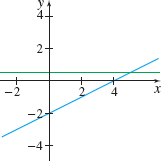
Question
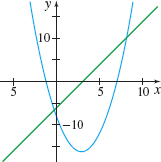
Question

In Problems 27–30, use the graph of f to obtain the graph of \(f^\prime\).
Question

Question
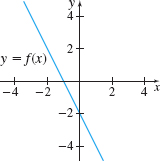
Question

Question
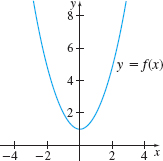
In Problems 31–34, the graph of a function f is given. Match each graph to the graph of its derivative \(f^\prime\) in A–D.
Question
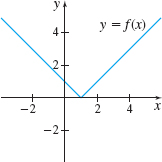
Question
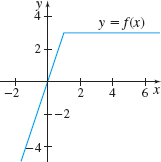
161
Question
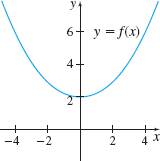
Question
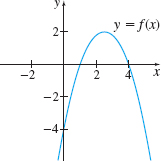
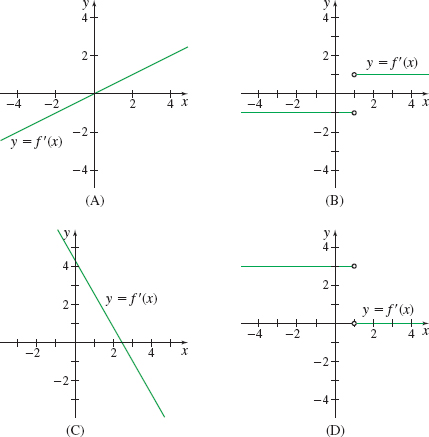
In Problems 35–44, determine whether each function f has a derivative at c. If it does, what is \(f^\prime ( c) ?\) If it does not, give the reason why.
Question
\(f( x) =x^{2/3}\) at \(c=-8\)
Question
\(f( x) =2x^{1/3}\) at \(c=0\)
Question
\(f(x)=|x^{2}-4|\) at \(c=2\)
Question
\(f(x)=\vert x^{2}-4|\) at \(c=-2\)
Question
\(f(x)=\left\{ \begin{array}{@{}l@{\quad}l} {\ \begin{array}{@{}l@{\quad}ll} 2x+3 &\hbox{if} & x < 1 \\ x^{2}+4 &\hbox{if} & x ≥ 1 \end{array} } &\hbox{at} & c=1 \end{array} \right.\)
Question
\(f(x)=\left\{ \begin{array}{@{}l@{\quad}l} {\ \begin{array}{@{}l@{\quad}ll} 3-4x &\hbox{if} & x < -1 \\ 2x+9 &\hbox{if} & x ≥ -1 \end{array} } &\hbox{at} & c=-1 \end{array} \right.\)
Question
\(f(x)=\left\{ \begin{array}{@{}l@{\quad}l} {\ \begin{array}{@{}l@{\quad}ll} -4+2x &\hbox{if} & x ≤ \dfrac{1}{2} \\ 4x^{2}-4 &\hbox{if} & x > \dfrac{1}{2} \end{array} } &\hbox{at} & c=\dfrac{1}{2} \end{array} \right.\)
Question
\(f(x)=\left\{ \begin{array}{@{}l@{\quad}l} {\ \begin{array}{@{}l@{\quad}ll} 2x^{2}+1 &\hbox{if} & x < -1 \\[3pt] -1-4x &\hbox{if} & x ≥ -1 \end{array} } &\hbox{at} & c=-1 \end{array} \right.\)
Question
\(f(x)=\left\{ \begin{array}{@{}l@{\quad}l} {\ \begin{array}{@{}l@{\quad}ll} 2x^{2}+1 &\hbox{if} & x < -1 \\[3pt] 2+2x &\hbox{if} & x ≥ -1 \end{array} } &\hbox{at} & c=-1 \end{array} \right.\)
Question
\(f(x)=\left\{ \begin{array}{@{}l@{\quad}l} {\ \begin{array}{@{}l@{\quad}ll} 5-2x &\hbox{if} & x < 2 \\ x^{2} &\hbox{if} & x ≥ 2 \end{array} } &\hbox{at} & c=2 \end{array} \right.\)
In Problems 45 and 46, use the given points \((c, f(c))\) on the graph of the function f.
- For which numbers c does \(\lim\limits_{x\rightarrow c}f(x)\) exist but \(f\) is not continuous at \(c\)?
- For which numbers c is f continuous at c but not differentiable at c?
Question

Question
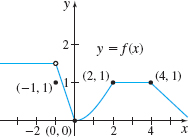
Heaviside Functions In Problems 47 and 48:
- Determine if the given Heaviside function is differentiable at \(c\).
- Give a physical interpretation of each function.
Question
\(u_{1}( t) =\left\{ \begin{array}{l@{\quad}ll} 0 &\hbox{if} & t < 1 \\ 1 &\hbox{if} & t ≥ 1 \end{array} \right.\) at \(c=1\)
Question
\(u_{3}( t) =\left\{ \begin{array}{l@{\quad}ll} 0 &\hbox{if} & t < 3 \\ 1 &\hbox{if} & t ≥ 3 \end{array} \right.\) at \(c=3\)
In Problems 49–52, find the derivative of each function.
Question
\(f(x)=mx+b\)
Question
\(f(x)=ax^{2}+bx+c\)
Question
\(f(x)=\dfrac{1}{x^{2}}\)
Question
\(f(x)=\dfrac{1}{\sqrt{x}}\)
Applications and Extensions
In Problems 53–60, each limit represents the derivative of a function f at some number c. Determine f and c in each case.
Question
\({\lim\limits_{h\rightarrow 0}\dfrac{(2+h)^{2}-4}{h} }\)
Question
\({\lim\limits_{h\rightarrow 0}\dfrac{(2+h)^{3}-8}{h} }\)
Question
\({\lim\limits_{x\rightarrow 1}\dfrac{x^{2}-1}{x-1}}\)
Question
\({\lim\limits_{x\rightarrow 1}\dfrac{x^{14}-1}{x-1}}\)
Question
\({\lim\limits_{x\rightarrow {\pi /6}}\dfrac{\sin x- \dfrac{1}{2}}{x-\dfrac{\pi }{6}}}\)
Question
\({ \lim\limits_{x\rightarrow {\pi /4}}\dfrac{\cos x-\dfrac{\sqrt{2}}{2}}{ x-\dfrac{\pi }{4}}}\)
Question
\({\lim\limits_{x\rightarrow 0}\dfrac{2(x+2)^{2}-(x+2)-6}{x}}\)
Question
\({\lim\limits_{x \rightarrow 0}\dfrac{3x^{3}-2x}{x}}\)
Question
For the function \(f(x)=\left\{ \begin{array}{l@{\quad}ll} x^{3} &\hbox{if} & x ≤ 0 \\ x^{2} &\hbox{if} & x>0 \end{array} \right.\), determine whether:
- \(f\) is continuous at 0.
- \(f^\prime (0)\) exists.
- Graph the function \(f\) and its derivative \(f^\prime .\)
162
Question
For the function \(f(x)=\left\{ \begin{array}{l@{\quad}ll} 2x &\hbox{if} & x ≤ 0 \\ x^{2} &\hbox{if} & x>0 \end{array} \right. \), determine whether:
- \(f\) is continuous at 0.
- \(f^\prime (0)\) exists.
- Graph the function \(f\) and its derivative \(f^\prime .\)
Question
Velocity The distance \(s\) (in feet) of an automobile from the origin at time \(t\) (in seconds) is given by \[ s=s( t) =\left\{ \begin{array}{l@{\quad}ll} t^{3} &\hbox{if} & 0 ≤ t < 5 \\ 125 &\hbox{if} & t ≥ 5 \end{array} \right. \] (This could represent a crash test in which a vehicle is accelerated until it hits a brick wall at \(t=5{s}\).)
- Find the velocity just before impact (at \(t=4.99{s}\)) and just after impact (at \(t=5.01{s})\).
- Is the velocity function \(v=s\prime ( t)\) continuous at \(t=5?\)
- How do you interpret the answer to (b)?
Question
Population Growth A simple model for population growth states that the rate of change of population size \(P\) with respect to time \(t\) is proportional to the population size. Express this statement as an equation involving a derivative.
Question
Atmospheric Pressure Atmospheric pressure \(p\) decreases as the distance \(x\) from the surface of Earth increases, and the rate of change of pressure with respect to altitude is proportional to the pressure. Express this law as an equation involving a derivative.
Question
Electrical Current Under certain conditions, an electric current \(I\) will die out at a rate (with respect to time \(t\)) that is proportional to the current remaining. Express this law as an equation involving a derivative.
Question
Tangent Line Let \(f(x)=x^{2}+2\). Find all points on the graph of \(f\) for which the tangent line passes through the origin.
Question
Tangent Line Let \(f(x)=x^{2}-2x+1\). Find all points on the graph of \(f\) for which the tangent line passes through the point \((1,-1)\).
Question
Area and Circumference of a Circle A circle of radius \(r\) has area \(A=\pi r^{2}\) and circumference \(C=2\pi r.\) If the radius changes from \(r\) to \(r + \Delta r\), find the:
- Change in area
- Change in circumference
- Average rate of change of area with respect to radius
- Average rate of change of circumference with respect to radius
- Rate of change of circumference with respect to radius
Question
Volume of a Sphere The volume \(V\) of a sphere of radius \(r\) is \(V=\dfrac{4\pi r^{3}}{3}.\) If the radius changes from \(r\) to \(r+\Delta r\), find the:
- Change in volume
- Average rate of change of volume with respect to radius
- Rate of change of volume with respect to radius
Question
Use the definition of the derivative to show that \(f( x) =\left\vert x\right\vert\) has no derivative at \(0.\)
Question
Use the definition of the derivative to show that \(f( x) =\sqrt[3]{x}\) has no derivative at \(0.\)
Question
If \(f\) is an even function that is differentiable at \(c\), show that its derivative function is odd. That is, show \(f\prime (-c)=-f\prime (c)\).
Question
If \(f\) is an odd function that is differentiable at \(c\), show that its derivative function is even. That is, show \(f\prime (-c)=f\prime (c).\)
Question
Tangent Lines and Derivatives Let \(f\) and \(g\) be two functions, each with derivatives at \(c\). State the relationship between their tangent lines at \(c\) if:
- \(f\prime (c)=g\prime (c)\)
- \({f}\prime (c)=-{\dfrac{1}{g\prime (c)}}\)
- \(g\prime(c)\neq 0\)
Challenge Problems
Question
Let \(f\) be a function defined for all \(x.\) Suppose \(f\) has the following properties: \[ f(u+v)=f(u)f(v) \qquad f(0)=1 \qquad f\prime (0) \hbox{ exists} \]
- Show that \(f\prime (x)\) exists for all real numbers \(x.\)
- Show that \(f\prime (x)=f\prime (0)f(x)\).
Question
A function \(f\) is defined for all real numbers and has the following three properties: \[ f(1)=5\qquad f(3)=21 \qquad f(a+b)-f(a)=kab+2b^{2} \] for all real numbers \(a\) and \(b\) where \(k\) is a fixed real number independent of \(a\) and \(b\).
- Use \(a=1\) and \(b=2\) to find \(k\).
- Find \(f\prime (3)\).
- Find \(f\prime (x)\) for all real \(x\).
Question
A function \(f\) is periodic if there is a positive number \(p\) so that \(f(x+p)=f(x)\) for all \(x\). Suppose \(f\) is differentiable. Show that if \(f\) is periodic with period \(p\), then \(f\prime\) is also periodic with period \(p\).
